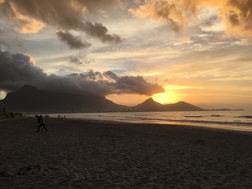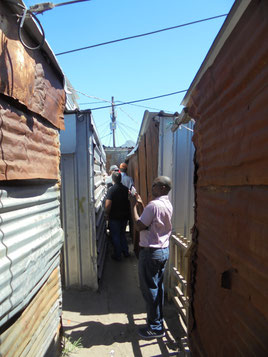
The beginning of 2018 saw Sarah-Jane Cooper-Knock and I head over to Cape Town to develop our project, in collaboration with project partners and our advisory board in the Western Cape. We were excited to see in person how the experimentations at the Stellenbosch University were developing; to build the foundations for our social survey work, and to re-visit informal settlements recently effected by fire to trace their recovery process.
It was fantastic to meet up with Dr Richard Walls, Dr Charles Kahanji, and Antonio Cicione from the Stellenbosch team. They have been doing important tests to capture important aspects of the spread of fire between informal dwellings. The early data from these tests highlights the unique characteristics of such fires, including their ferocity, the speed and paths of fire spread which might occur, and the temperatures that might be seen in real dwelling fires. This kind of data will be crucial in feeding other elements of research and shaping our policy recommendations. Later this year, for example, we will be using the team’s findings to shape large-scale tests, which will provide us with vital insights into settlement-wide fire spread. Only with such data can we start to develop evidence-based interventions into these devastating fires.

A fire experiment of three timber structures conducted by the Stellenbosch University team (Nov 2017)

Surveys are another important component of the IRIS-FIRE project. We will be taking a mixed method approach, using large-scale, quantitative surveys to provide insights into settlement histories, responses to past fires, and the size and contents of informal dwelling within a particular settlement. This will be supplemented by more in-depth, qualitative research that explores more complex questions, such as people’s ongoing relationships with local NGOs or the state.
On this trip, we were focused on setting the foundation for our quantitative survey. We had very productive meetings with the top three tenderers who have bid to conduct our survey work. The evolving draft survey was also developed in discussions with the Stellenbosch team, the advisory board, and informal settlement residents. Based on these conversations Sarah-Jane is now busy refining our draft, ready for pilot studies in the spring. Ultimately, the survey will give us data from around 600 households across 6 settlements. We aim to have our findings in by the end of the summer.

There are many factors that make design policy in this area a complicated task. One issue is that no two settlements are the same. Choosing a diverse mix of settlements to survey is an important part of the project. But it is also important that we remain aware of the experiences of residents in settlements beyond those surveyed. Each time we visit Cape Town, we make an effort to meet with informal settlement residents in different settlements to hear about their struggles with fire and the ways in which they have recovered and rebuilt after such fires. The experiences that such residents have faced in the midst and aftermath of such fires are devastating. We are constantly reminded of the scope and severity of challenges that residents encounter as well as their strength and dignity in the midst of issues that nobody should have to face.
Masiphumelele (Masi for short) is one settlement that has been beset by several major fires within the past few years. We were shown around the settlement by Mama Charlotte, who talked us through responses to fire and recovery processes in the area. Similarly, we were shown around Imizamo Yethu, where fire destroyed over 2000 homes in March 2017. The rebuilding here has been rapid, and whilst there is clearly much still to do (and much being done) residents have now moved from the recreational field where they were temporarily housed in the aftermath of the fire. I am looking forward to following the progress of both settlements over time.

Masi will also be the site for research on remote sensing, which is being led by Dr Lesley Gibson. She will be tracking the reflectiveness of dwellings as a way of mapping informal settlement fire histories in Masi, and beyond. To that end, we also took photographs to help with mapping pathways and access routes as well as visiting a local scrap yard to pick up some metal sheeting used within house construction for spectrometry analysis. That analysis will help us to better understand how these materials reflect light and will refine our capacity to map fire histories.
Finally, we met with our advisory panel – an evolving group of policy actors, practitioners and residents - who are deeply interested in the work we are doing in the Western Cape. The group included the Western Cape Disaster Management and Fire and Rescue Service, City of Cape Town Fire Service, Thula Thula (an NGO working in Imizamo Yethu with regards to fire safety) and a representative from Kyamandi, an informal settlement in Stellenbosch. It was fantastic to meet everyone and to discuss the project and particularly what each of the groups wanted from the research that we were conducting, and how they can support it and each other to help reduce the impact of fires in informal settlements.

I am looking forward to our next trip out to the Western Cape – where we will hopefully be able to meet more stakeholders, to see the surveys start to take place, and to visit more settlements and meet their resilient inhabitants.
by David Rush












Write a comment